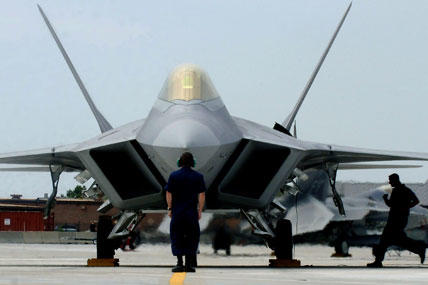Air Force leaders didn’t find the “smoking gun” they spent four years searching for after too many F-22 pilots felt short of breath, dizzy and nauseous in flight. The service found a faulty, 20-year-old valve.
This valve has forced the service to ground the Air Force’s most prized stealth fighter fleet for four months. And it’s led to embarrassing moments to include two Raptor pilots telling the nation on CBS’s 60 Minutes they refused to fly the jet because they feared for their lives.
Maj. Gen. Charles Lyon, the director of operations for Air Combat Command, said the service had “determined with confidence” they had found the cause of the breathing problems that have plagued the F-22 fleet since 2008.
Defense Secretary Leon Panetta accepted the Air Force’s findings and approved a deployment of 12 F-22s from Joint Base Langley-Eustis, Va., that arrived in Okinawa, Japan, on July 28. Air Force Chief of Staff Gen. Norton Schwartz said his service had determined the root cause of the problem July 26. Lyon provided more details Tuesday.
“In the end, there is no smoking gun, we’ve assembled the pieces of the mosaic that reside in the cockpit,” Lyon said.
Within that mosaic, Lyon singled out the Combat Edge upper pressure garment, connector hoses and valves. More specifically, he said the Air Force’s servicewide investigation faulted the breathing regulator/anti-G (BRAG) valve that inflates the vest.
The valve should inflate the vest when a pilot experiences increased G-forces while flying the jet. The vest helps the pilot control his breathing even when his body is being crushed by the pressure of multiple G-forces.
Service investigators found the valve inflated the vests inside the F-22 before pilots experienced high G-forces. Inflation of the vest in a normal state often caused the pilots to hyperventilate, which caused the breathing problems, Lyon said.
“It’s like putting a corset around your chest,” he said.
An F-22 pilot last reported an unexplained incident of hypoxia-like symptoms on March 8, Lyon said. The service has since flown nearly 8,000 F-22 sorties and over 10,000 flight hours.
The Air Force is testing a replacement valve that will properly inflate the vest. Lyon said it will be completed and sent to the entire fleet by the end of the calendar year.
Panetta placed altitude restrictions on the F-22 fleet on May 15. He also limited the service to flying training missions to no more than 30-minute flights from base. Lyon said the service must finish testing the replacement valve before taking the next step toward lifting the restrictions set by the defense secretary.
Air Force F-15 and F-16 pilots started wearing the valve on their vests in 1992. F-22 pilots followed suit when the stealth fighter entered the service.
Eagle and Viper pilots stopped wearing the upper pressure garments in 2004 “because they were not giving us the contribution we thought they would,” Lyon said. F-22 pilots kept wearing them because they flew at higher altitudes and the vests protected the pilots from “rapid decompression,” he said.
The Air Force ordered F-22 pilots to stop wearing the vests in June. Lyon explained that F-22 pilots, many of whom flew the F-15 and F-16, didn’t notice the vests had inflated early because of the layers of gear a pilot wears in flight.
“It never reached a point of significance with the flying community. Many pilots didn’t notice the inflation in flight,” Lyon said.
Some pilots in the Air Force have questioned why it took the Air Force this long to find the problem and why the vest could cause the pilots to hyperventilate if they couldn’t feel the inflation of the vest.
“Either way, the Air Force is incompetent for missing this until now, or dishonest and trying to sweep something under the rug,” said an F-16 pilot who asked not to have his name used. “Not good options.”
The Air Force had at first pegged air contaminants as the cause of the breathing problems, Lyon said. Reports of maintainers experiencing hypoxia-like symptoms alarmed the service.
Comprehensive testing has since ruled out contaminants as the cause, Lyon said. Filters installed into F-22 cockpits to protect pilots from these suspected contaminants have only made the problem worse, he said.
Beside the replacement valves, F-22 pilots can expect additional gear to protect them from breathing problems. Service officials will replace the finger-mounted pulse-oximeter with one mounted to a pilot’s helmet. Pilots will also receive a new oxygen sensor and backup oxygen supply.
Lyon warned that pilots flying the F-22 and other fighters will continue to experience “physiological incidents” to include shortness of breath even with these new tools. It “goes with the territory in high performance fighter aircraft,” Lyon said.
The mystery surrounding the breathing problems is what caused the Air Force to ground its stealth fighter fleet in 2011.
“What gave the Air Force grave concern last year when we stood down the fleet was the unexplained nature of the incidents and the incident rates. We now have an explanation and the incident rate is decreasing,” Lyon said.
The two-star general said he has the support of the F-22 community. He doesn’t expect to see any other pilots refuse to fly the jet or go on national television with their concerns. In fact, he said one of the two Virginia National Guard pilots that went on 60 Minutes has returned to flight status.
A Virginia National Guard spokesman would not specify which pilot returned to flight status or the standing of the other pilot within the Guard.
““I recently visited our F-22 bases and can tell you their confidence is high. There is no other aircraft our pilots would rather fly,” Lyon said.






























